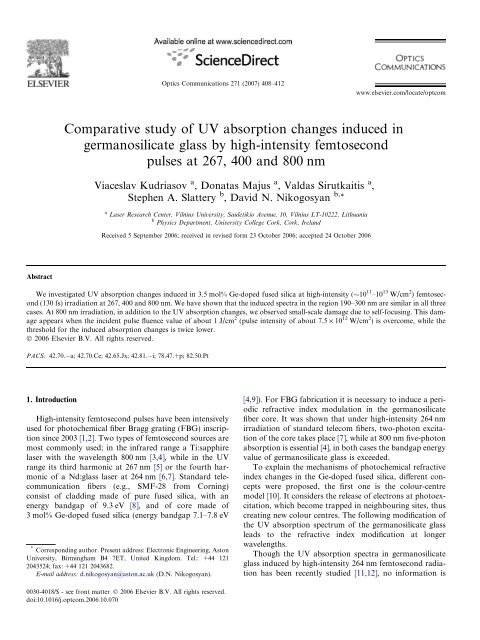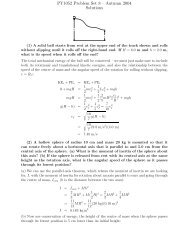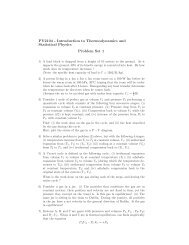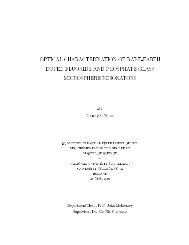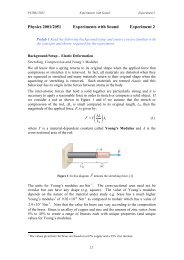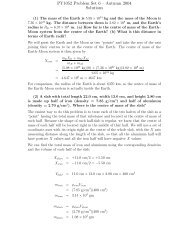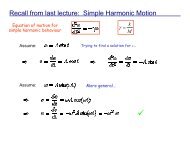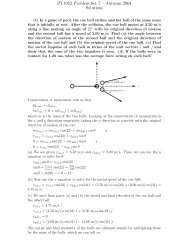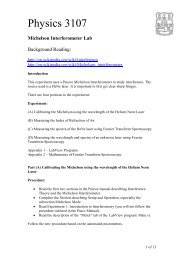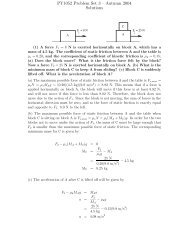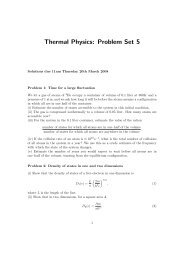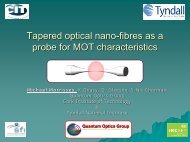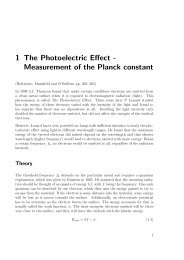Comparative study of UV absorption changes induced in ...
Comparative study of UV absorption changes induced in ...
Comparative study of UV absorption changes induced in ...
You also want an ePaper? Increase the reach of your titles
YUMPU automatically turns print PDFs into web optimized ePapers that Google loves.
Optics Communications 271 (2007) 408–412www.elsevier.com/locate/optcom<strong>Comparative</strong> <strong>study</strong> <strong>of</strong> <strong>UV</strong> <strong>absorption</strong> <strong>changes</strong> <strong><strong>in</strong>duced</strong> <strong>in</strong>germanosilicate glass by high-<strong>in</strong>tensity femtosecondpulses at 267, 400 and 800 nmViaceslav Kudriasov a , Donatas Majus a , Valdas Sirutkaitis a ,Stephen A. Slattery b , David N. Nikogosyan b, *a Laser Research Center, Vilnius University, Sauletikio Avenue, 10, Vilnius LT-10222, Lithuaniab Physics Department, University College Cork, Cork, IrelandReceived 5 September 2006; received <strong>in</strong> revised form 23 October 2006; accepted 24 October 2006AbstractWe <strong>in</strong>vestigated <strong>UV</strong> <strong>absorption</strong> <strong>changes</strong> <strong><strong>in</strong>duced</strong> <strong>in</strong> 3.5 mol% Ge-doped fused silica at high-<strong>in</strong>tensity (10 11 –10 13 W/cm 2 ) femtosecond(130 fs) irradiation at 267, 400 and 800 nm. We have shown that the <strong><strong>in</strong>duced</strong> spectra <strong>in</strong> the region 190–300 nm are similar <strong>in</strong> all threecases. At 800 nm irradiation, <strong>in</strong> addition to the <strong>UV</strong> <strong>absorption</strong> <strong>changes</strong>, we observed small-scale damage due to self-focus<strong>in</strong>g. This damageappears when the <strong>in</strong>cident pulse fluence value <strong>of</strong> about 1 J/cm 2 (pulse <strong>in</strong>tensity <strong>of</strong> about 7.5 · 10 12 W/cm 2 ) is overcome, while thethreshold for the <strong><strong>in</strong>duced</strong> <strong>absorption</strong> <strong>changes</strong> is twice lower.Ó 2006 Elsevier B.V. All rights reserved.PACS: 42.70. a; 42.70.Ce; 42.65.Jx; 42.81. i; 78.47.+p; 82.50.Pt1. IntroductionHigh-<strong>in</strong>tensity femtosecond pulses have been <strong>in</strong>tensivelyused for photochemical fiber Bragg grat<strong>in</strong>g (FBG) <strong>in</strong>scriptions<strong>in</strong>ce 2003 [1,2]. Two types <strong>of</strong> femtosecond sources aremost commonly used; <strong>in</strong> the <strong>in</strong>frared range a Ti:sapphirelaser with the wavelength 800 nm [3,4], while <strong>in</strong> the <strong>UV</strong>range its third harmonic at 267 nm [5] or the fourth harmonic<strong>of</strong> a Nd:glass laser at 264 nm [6,7]. Standard telecommunicationfibers (e.g., SMF-28 from Corn<strong>in</strong>g)consist <strong>of</strong> cladd<strong>in</strong>g made <strong>of</strong> pure fused silica, with anenergy bandgap <strong>of</strong> 9.3 eV [8], and <strong>of</strong> core made <strong>of</strong>3 mol% Ge-doped fused silica (energy bandgap 7.1–7.8 eV* Correspond<strong>in</strong>g author. Present address: Electronic Eng<strong>in</strong>eer<strong>in</strong>g, AstonUniversity, Birm<strong>in</strong>gham B4 7ET, United K<strong>in</strong>gdom. Tel.: +44 1212043524; fax: +44 121 2043682.E-mail address: d.nikogosyan@aston.ac.uk (D.N. Nikogosyan).[4,9]). For FBG fabrication it is necessary to <strong>in</strong>duce a periodicrefractive <strong>in</strong>dex modulation <strong>in</strong> the germanosilicatefiber core. It was shown that under high-<strong>in</strong>tensity 264 nmirradiation <strong>of</strong> standard telecom fibers, two-photon excitation<strong>of</strong> the core takes place [7], while at 800 nm five-photon<strong>absorption</strong> is essential [4], <strong>in</strong> both cases the bandgap energyvalue <strong>of</strong> germanosilicate glass is exceeded.To expla<strong>in</strong> the mechanisms <strong>of</strong> photochemical refractive<strong>in</strong>dex <strong>changes</strong> <strong>in</strong> the Ge-doped fused silica, different conceptswere proposed, the first one is the colour-centremodel [10]. It considers the release <strong>of</strong> electrons at photoexcitation,which become trapped <strong>in</strong> neighbour<strong>in</strong>g sites, thuscreat<strong>in</strong>g new colour centres. The follow<strong>in</strong>g modification <strong>of</strong>the <strong>UV</strong> <strong>absorption</strong> spectrum <strong>of</strong> the germanosilicate glassleads to the refractive <strong>in</strong>dex modification at longerwavelengths.Though the <strong>UV</strong> <strong>absorption</strong> spectra <strong>in</strong> germanosilicateglass <strong><strong>in</strong>duced</strong> by high-<strong>in</strong>tensity 264 nm femtosecond radiationhas been recently studied [11,12], no <strong>in</strong>formation is0030-4018/$ - see front matter Ó 2006 Elsevier B.V. All rights reserved.doi:10.1016/j.optcom.2006.10.070
V. Kudriasov et al. / Optics Communications 271 (2007) 408–412 409available <strong>in</strong> literature on the <strong>absorption</strong> spectra <strong><strong>in</strong>duced</strong> byhigh-<strong>in</strong>tensity 800 nm pulses. In this work, we report on acomparative <strong>study</strong> <strong>of</strong> <strong><strong>in</strong>duced</strong> <strong>absorption</strong> spectra <strong>in</strong>3.5 mol% Ge-doped fused silica, caused by high-<strong>in</strong>tensity(10 11 –10 13 W/cm 2 ) femtosecond pulses with differentwavelengths (267, 400 and 800 nm). The accompany<strong>in</strong>gglass damage due to self-focus<strong>in</strong>g was also studied underthese experimental conditions.2. Experimental set-upFemtosecond pulses at 800 nm wavelength were producedby a Ti:sapphire chirped pulse amplification lasersystem [13]. This laser system delivers 1 mJ pulses with130 fs duration at 800 nm with a repetition rate <strong>of</strong> 1 kHz.The pulse duration was measured us<strong>in</strong>g a multishot autocorrelatorbased on a BBO crystal, cut for type I noncoll<strong>in</strong>earsecond harmonic generation (h =29°, u =90°). The IRbeam diameter (3.5 mm at FWHM) was measured us<strong>in</strong>g a14-bit CCD camera with a pixel number <strong>of</strong> 1200 · 1024and a pixel size <strong>of</strong> 4.65 · 4.65 lm. The 800 nm beam pr<strong>of</strong>ilewas 90% fit by Gaussian distribution. The pulses at 400 nmwere produced by frequency doubl<strong>in</strong>g <strong>of</strong> the fundamentalwave <strong>in</strong> a 1 mm thick BBO crystal cut for type I coll<strong>in</strong>earsecond harmonic generation (h = 29.2°, u =90°). The secondharmonic beam was separated from the fundamentalone by us<strong>in</strong>g two beamsplitters with a high reflection at400 nm. The pulses at the third harmonic <strong>of</strong> the fundamental(267 nm) were produced by sum-frequency mix<strong>in</strong>g. Thepulses <strong>of</strong> the fundamental wave (800 nm) and its secondharmonic (400 nm) were directed <strong>in</strong>to a 1.5 mm thickBBO crystal cut for type I sum-frequency generation (h =44.3°, u =90°). The angle between the 800 nm and400 nm beams was about 2° <strong>in</strong> the horizontal plane. Us<strong>in</strong>gmirrors, highly reflect<strong>in</strong>g at 267 nm, and the spatial walk<strong>of</strong>f<strong>of</strong> the sum-frequency beam, we easily reached separation<strong>of</strong> the ultraviolet radiation.To change the pulse <strong>in</strong>tensity we slightly focused thefundamental laser beam (or its harmonics) us<strong>in</strong>g a fused silicalens with a focal distance <strong>of</strong> 50.2 cm (for 800 nm) or48.5 cm (for 400 nm) and a CaF 2 lens with a focal distance<strong>of</strong> 47 cm (for 267 nm). For the exact calculation <strong>of</strong> <strong>in</strong>tensitywe used the expressions given <strong>in</strong> [14].In the experiments, we used 3.5 mol% Ge-doped samples<strong>of</strong> germanosilicate glass, similar to those <strong>in</strong>vestigated earlier[11,12]. The thickness <strong>of</strong> the samples was 0.085 cm.For spectral measurements <strong>of</strong> the <strong><strong>in</strong>duced</strong> <strong>absorption</strong><strong>changes</strong>, the samples were fixed on diaphragms, throughwhich the femtosecond laser beam was directed. The diameters<strong>of</strong> the diaphragms were 0.6 mm (for 800 nm pulses)and 1 mm (for 267 and 400 nm pulses). Care was takento <strong>in</strong>stall the diaphragm each time <strong>in</strong> exactly the same positionon the optical bench or <strong>in</strong>side the <strong>UV</strong> spectrophotometer(<strong>UV</strong>-3101PC, Shimadzu, Japan).For the observation <strong>of</strong> the sample damage after the irradiationwe used an optical transmission microscope with a10 · magnification.3. Results and discussionFig. 1 demonstrates the experimental difference <strong>absorption</strong>spectra, taken at 800, 400 and 267 nm with different<strong>in</strong>cident <strong>in</strong>tensities and fluences values. It is clear that theobta<strong>in</strong>ed spectra are qualitatively similar. This means thatthe colour-centre model could expla<strong>in</strong> the photosensitivity<strong>of</strong> germanosilicate glass not only when irradiat<strong>in</strong>g by femtosecondpulses at 267 nm, but also when us<strong>in</strong>g high-<strong>in</strong>tensity800 and 400 nm pulses. As it follows from Fig. 1, thechange <strong>in</strong> the irradiation wavelength from 267 nm to400 nm and further to 800 nm is accompanied by the substantial<strong>in</strong>crease <strong>of</strong> irradiation <strong>in</strong>tensity needed for a similarchange <strong>in</strong> <strong>UV</strong> <strong>absorption</strong>, from 200 to 10000 GW/cm 2 . This is <strong>in</strong> l<strong>in</strong>e with the change <strong>in</strong> the order <strong>of</strong> the nonl<strong>in</strong>ear<strong>absorption</strong> process, from the two-photon <strong>in</strong> the case<strong>of</strong> 267 nm [7] to the five-photon <strong>in</strong> the case <strong>of</strong> 800 nm [4].Inthe case <strong>of</strong> 400 nm excitation it should probably be a threephoton<strong>absorption</strong> process, similar to that recently demonstratedfor the 352 nm femtosecond grat<strong>in</strong>g <strong>in</strong>scription <strong>in</strong> atelecom fiber [15].It should be noted that at 800 nm irradiation, <strong>in</strong> additionto <strong>UV</strong> <strong>absorption</strong> <strong>changes</strong>, we observed small-scaledamage (Fig. 2). The observed back surface morphologycould be expla<strong>in</strong>ed only as a result <strong>of</strong> beam small-scaleself-focus<strong>in</strong>g and whole beam break<strong>in</strong>g <strong>in</strong>to <strong>in</strong>tense filaments<strong>in</strong>side the material. Indeed, the damage structurewas observed not only on the back surface, but had alsoalready begun <strong>in</strong>side the volume. The number <strong>of</strong> damagepo<strong>in</strong>ts <strong>in</strong>creased as the back surface was approach<strong>in</strong>g.The appearance <strong>of</strong> small-scale damage was accompaniedby a strong fluorescence. We did not f<strong>in</strong>d any such damageeither at 267 nm or at 400 nm. This is probably due to themuch higher s<strong>in</strong>gle pulse <strong>in</strong>cident fluence value (up to 1.3 J/cm 2 ) <strong>in</strong> the 800 nm case.The next goal was to determ<strong>in</strong>e the <strong>in</strong>tensity thresholdsfor the <strong><strong>in</strong>duced</strong> l<strong>in</strong>ear <strong>absorption</strong> <strong>changes</strong> and for the opticaldamage at 800 nm. In this experiment, we exposed thedifferent samples with the same number <strong>of</strong> expos<strong>in</strong>g pulses(5 · 10 5 ) but with vary<strong>in</strong>g values <strong>of</strong> <strong>in</strong>cident energy from600 to 150 lJ, so simultaneously the <strong>in</strong>cident <strong>in</strong>tensityand fluence were changed. For better accuracy <strong>of</strong> the <strong>in</strong>tensityvalue, the 800 nm beam diameter was measured at thesample plane, the FWHM value was found to be <strong>of</strong>160 lm. For the reason <strong>of</strong> reach<strong>in</strong>g better sensitivitytowards small <strong>absorption</strong> <strong>changes</strong> we used the smaller diaphragm<strong>of</strong> 0.4 mm diameter. This, however, brought morenoise to the measured difference <strong>absorption</strong> spectra.Our results for different <strong>in</strong>cident irradiation <strong>in</strong>tensitiesrelative to the 800 nm case are presented <strong>in</strong> Fig. 3. Westarted at highest pulse energy (600 lJ), where the <strong>absorption</strong>change and the damage were clearly visible. Decreas<strong>in</strong>gthe energy resulted <strong>in</strong> decrease <strong>of</strong> the number <strong>of</strong>damage po<strong>in</strong>ts on the output sample surface (Fig. 4). Visibledamage disappeared fully when the energy droppedbelow the value <strong>of</strong> 300 lJ, correspond<strong>in</strong>g to an <strong>in</strong>tensity<strong>of</strong> 7.5 · 10 12 W/cm 2 . However, the effect <strong>of</strong> the <strong><strong>in</strong>duced</strong>
410 V. Kudriasov et al. / Optics Communications 271 (2007) 408–4123L<strong>in</strong>ear Absorption Coefficient Change [cm -1 ]21800 nm1203 4 5 6 7Quantum Energy [eV]Fig. 2. Microphotograph <strong>of</strong> small-scale damage <strong>in</strong> 3.5 mol% Ge-dopedfused silica taken at the back surface <strong>of</strong> the sample. Incident <strong>in</strong>tensity,pulse fluence and number <strong>of</strong> laser pulses were 9.2 · 10 12 W/cm 2 , 1.2 J/cm 2and 3 · 10 6 .3L<strong>in</strong>ear Absorption Coefficient Change [cm -1 ]L<strong>in</strong>ear Absorption Coefficient Change [cm -1 ]6420210400 nm3 4 5 6 7267 nmQuantum Energy [eV]3 4 5 6 7Quantum Energy [eV]Fig. 1. Difference <strong>absorption</strong> spectra <strong><strong>in</strong>duced</strong> by high-<strong>in</strong>tensity femtosecond800, 400 and 267 nm pulses <strong>in</strong> 3.5 mol% Ge-doped fused silica.Incident <strong>in</strong>tensity and fluence values were: (1) 9.2 · 10 12 W/cm 2 , 289.2 kJ/cm 2 ; (2) 9.1 · 10 12 W/cm 2 , 85.7 kJ/cm 2 ; (3) 3.9 · 10 12 W/cm 2 , 30.1 kJ/cm 2 ;(4) 2.8 · 10 12 W/cm 2 , 29.5 kJ/cm 2 ; (5) 2.3 · 10 11 W/cm 2 , 0.361 kJ/cm 2 ; (6)2.3 · 10 11 W/cm 2 , 0.025 kJ/cm 2 .3456L<strong>in</strong>ear Absorption Coefficient Change [cm -1 ]3210800 nm3 4 5 6 7Quantum Energy [eV]Fig. 3. Difference <strong>absorption</strong> spectra <strong><strong>in</strong>duced</strong> by high-<strong>in</strong>tensity femtosecond800 nm pulses <strong>in</strong> 3.5 mol% Ge-doped fused silica. Incident <strong>in</strong>tensity,<strong>in</strong>cident fluence and absorbed fluence values were: (1) 14.9 · 10 12 W/cm 2 ,239 kJ/cm 2 , 64.5 kJ/cm 2 ; (2) 8.7 · 10 12 W/cm 2 , 139 kJ/cm 2 , 19.5 kJ/cm 2 ;(3) 6.2 · 10 12 W/cm 2 , 99.5 kJ/cm 2 , 8.0 kJ/cm 2 ; (4) 5.0 · 10 12 W/cm 2 ,79.6 kJ/cm 2 , 4.0 kJ/cm 2 ; (5) 3.7 · 10 12 W/cm 2 , 59.7 kJ/cm 2 , 0 kJ/cm 2 .<strong>absorption</strong> change rema<strong>in</strong>ed until the second threshold(150 lJ or 3.7 · 10 12 W/cm 2 ) was reached. Interest<strong>in</strong>gly,at the same time the absorbed fluence decreased from65 kJ/cm 2 (600 lJ) to 12 kJ/cm 2 (300 lJ) and further tozero at 150 lJ.The presence <strong>of</strong> two thresholds at high-<strong>in</strong>tensity 800 nmirradiation correspond<strong>in</strong>g to two types <strong>of</strong> damage, fullyreversible by 900 °C heat<strong>in</strong>g (type I) and irreversible (typeII), was found for pure fused silica <strong>in</strong> 2001 [16]. The thresholdfor the type II damage corresponded well to the criticalpower <strong>of</strong> self-focus<strong>in</strong>g <strong>of</strong> 800 nm laser radiation <strong>in</strong> fusedsilica glass. Recently, the existence <strong>of</strong> two different <strong>in</strong>tensitythresholds related to two different types <strong>of</strong> fiber photosensitivitywas established <strong>in</strong> experiments on femtosecond800 nm FBG <strong>in</strong>scription <strong>in</strong> 3 mol% germanosilicate glass12345
V. Kudriasov et al. / Optics Communications 271 (2007) 408–412 411value for s<strong>in</strong>gle-quantum 248 nm type II FBG <strong>in</strong>scription<strong>in</strong> 15 mol% germanosilicate glass (0.22 J/cm 2 ) [17]. Therefore,the obta<strong>in</strong>ed experimental data testify that the typeII fiber photosensitivity at high-<strong>in</strong>tensity 800 nm femtosecondirradiation is l<strong>in</strong>ked with the self-focus<strong>in</strong>g <strong>in</strong> germanosilicateglass.4. ConclusionWe observed a similarity between the <strong><strong>in</strong>duced</strong> <strong>absorption</strong>change spectra <strong>in</strong> the case <strong>of</strong> high-<strong>in</strong>tensity femtosecondexcitation <strong>of</strong> 3.5 mol% germanosilicate glass at 267,400 and 800 nm. This means that the colour-centre modelcould expla<strong>in</strong> the type I photosensitivity <strong>of</strong> germanosilicateglass <strong>in</strong> all these three cases. At 800 nm irradiation, <strong>in</strong> additionto <strong>UV</strong> <strong>absorption</strong> <strong>changes</strong>, we observed small-scaledamage due to self-focus<strong>in</strong>g (type II irreversible damage).This damage appeared when the characteristic <strong>in</strong>cidentpulse fluence value <strong>of</strong> about 1 J/cm 2 (pulse <strong>in</strong>tensity <strong>of</strong>about 7.5 · 10 12 W/cm 2 ) is overcome, while the thresholdfor the <strong><strong>in</strong>duced</strong> <strong>absorption</strong> <strong>changes</strong> at 800 nm was twicelower.AcknowledgementsThis <strong>in</strong>vestigation was made <strong>in</strong> the frame <strong>of</strong> the Laserlab-EuropeProject vulrc001261. The authors from UniversityCollege Cork, Cork, Ireland wish to thank theEuropean Commission for fund<strong>in</strong>g this project. We arealso grateful to Pr<strong>of</strong>. Peter Kazansky for support<strong>in</strong>g uswith a sample <strong>of</strong> germanosilicate glass and to Pr<strong>of</strong>. AlgisPiskarskas for the cont<strong>in</strong>uous support.ReferencesFig. 4. Optical damage <strong>of</strong> the germanosilicate glass sample for different<strong>in</strong>cident <strong>in</strong>tensity and total accumulated <strong>in</strong>cident fluence values: (1)14.9 · 10 12 W/cm 2 , 1.03 MJ/cm 2 ; (2) 8.7 · 10 12 W/cm 2 , 0.60 MJ/cm 2 ; (3)7.5 · 10 12 W/cm 2 , 0.52 MJ/cm 2 . The number <strong>of</strong> expos<strong>in</strong>g laser pulses was500,000.[4]. The direct comparison with our damage threshold isdifficult due to the uncerta<strong>in</strong>ties <strong>in</strong> absorbed fluence <strong>in</strong> bothstudies. However, our measured absorbed fluence thresholdvalue (0.1 J/cm 2 ) for small-scale damage <strong>in</strong> 3.5 mol%Ge-doped fused silica agrees fairly well with the threshold[1] S.J. Mihailov, C.W. Smelser, P. Lu, R.B. Walker, D. Grobnic, H.D<strong>in</strong>g, G. Henderson, J. Unruh, Opt. Lett. 28 (12) (2003) 995.[2] A. Dragomir, D.N. Nikogosyan, K.A. Zagorulko, P.G. Kryukov,E.M. Dianov, Opt. Lett. 28 (22) (2003) 2171.[3] S.J. Mihailov, C.W. Smelser, D. Grobnic, R.B. Walker, P. Lu, H.D<strong>in</strong>g, J. Unruh, J. Lightwave Technol. 22 (1) (2004) 94.[4] C.W. Smelser, S.J. Mihailov, D. Grobnic, Opt. Express 13 (14) (2005)5377.[5] K.A. Zagorulko, P.G. Kryukov, Y.V. Larionov, A.A. Rybaltovsky,E.M. Dianov, S.V. Chekal<strong>in</strong>, Y.A. Matveets, V.O. Kompanets, Opt.Express 12 (24) (2004) 5996.[6] S.A. Slattery, D.N. Nikogosyan, N. Plougmann, H.R. Sørensen, M.Kristensen, Electron. Lett. 40 (23) (2004) 1472.[7] S.A. Slattery, D.N. Nikogosyan, G. Brambilla, J. Opt. Soc. Am. B 22(2) (2005) 354; Errata, J. Opt. Soc. Am. B 22 (5) (2005) 1143.[8] Z.A. We<strong>in</strong>berg, G.W. Rubl<strong>of</strong>f, E. Bassous, Phys. Rev. B 19 (6) (1979)3107.[9] J. Nishii, N. Kitamura, H. Yamanaka, H. Hosono, H. Kawazoe, Opt.Lett. 20 (10) (1995) 1184.[10] D.P. Hand, P.St.J. Russell, Opt. Lett. 15 (2) (1990) 102.[11] A. Dragomir, J.G. McInerney, D.N. Nikogosyan, P.G. Kazansky,Appl. Phys. Lett. 80 (7) (2002) 1114.[12] A.I. Kalachev, D.N. Nikogosyan, G. Brambilla, J. LightwaveTechnol. 23 (8) (2005) 2568.[13] V. Kudriasov, E. Gaizauskas, V. Sirutkaitis, J. Opt. Soc. Am. B 22(12) (2005) 2619.
412 V. Kudriasov et al. / Optics Communications 271 (2007) 408–412[14] A. Dragomir, J.G. McInerney, D.N. Nikogosyan, Appl. Opt. 41 (21)(2002) 4365.[15] M. Dubov, I. Bennion, S.A. Slattery, D.N. Nikogosyan, Opt. Lett. 30(19) (2005) 2533.[16] L. Sudrie, M. Franco, B. Prade, A. Mysyrowicz, Opt. Commun. 191(4–6) (2001) 333.[17] J.L. Archambault, L. Reekie, P.St.J. Russell, Electron. Lett. 29 (5)(1993) 453.


